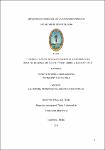VIH/SIDA y caries dental en pacientes atendidos en el Hospital Regional de Loreto "Felipe Arriola Iglesias", 2014

View/
Date
2014Author
Cubas Sánchez, Darwin Mitchel
Flores Vela, Reyna Jeny
Metadata
Show full item recordAbstract
El presente estudio, tuvo como objetivo comprobar la existencia de relación entre caries dental y VIH/SIDA. El tipo de investigación fue cuantitativa, el diseño fue no experimental correlacional, transversal. La muestra estuvo conformada por 70 pacientes con diagnóstico de VIH/SIDA atendidos en el Hospital Regional de Loreto. El instrumento utilizado para el presente estudio comparativo fue la Ficha para determinar el nivel de caries dental y la ficha de consentimiento informado. El CPOD de la muestra fue 12,47. El promedio de dientes con caries dental fue 7,64; de dientes perdidos fue 4,14 y de obturados 0,69. El máximo de piezas cariadas fue 9 representando el 15.7%. El mínimo fue 14 representando el 1.4%. El 37,1% no presento piezas perdidas. El mínimo de piezas perdidas fue 1 con el 10% y el máximo fue 23 con el 1,4%. El 71,4% no presentó obturación alguna, el 8,6% presentó 1 obturación, el 8,6% presentó 2 obturaciones, 5,7% presentó 3, el 2,9% presentó 4 y el 2,9% presentó 5 obturaciones. El grupo de 30 a 59 años fue el más prevalente con el 62,9%, seguido de los de 18 a 29 años con un 25,7%. En el recuento de CD4 el 45.7% presento menor de 200 y el 45.7% de 200 a 500, el 8.6 presento mayor a 500 linfocitos. Se analizaron la relación entre las variables. A la prueba de Correlación de Spearman's no hay relación entre el VIH/SIDA (CD4) y el nivel de caries dental (p=0,485). No hay relación entre CD4 y dientes cariados, CD4 y dientes perdidos y CD4 y dientes obturados con 0.534, 0.218 y 0.893 respectivamente. Tampoco se encontró relación entre dientes cariados y obturados (p= 0.779), entre dientes perdidos y obturados (p= 0.639). Sin embargo hay relación entre los dientes cariados y los dientes perdidos (p= 0,018) The present study aimed to verify the existence of relationship between dental caries and HIV / AIDS. The research was quantitative, non-experimental design was correlational, cross. The sample consisted of 70 patients diagnosed with HIV / AIDS treated at the Regional Hospital of Loreto. The instrument used for this comparative study was the card to determine the level of dental caries and informed consent sheet. The DMFT of the sample was 12.47. The average teeth with dental caries were 7.64; missing teeth was 0.69 4.14 and sealed. The maximum number of decayed pieces was 9 representing 15.7%. The minimum was 14 accounting for 1.4%. 37.1% did not present missing parts. The minimum was missing pieces 1 with 10% and the maximum was 23 to 1.4%. 71.4% had no shutter some, 8.6% had one shutter, 8.6% had two seals, and 5.7% had three, 2.9% had 4 and 2.9% had five fillings. The group of 30-59 years was the most prevalent with 62.9%, followed by those of 18-29 years with 25.7%. In the CD4 count 45.7% showed less than 200 and 45.7% of 200-500, 8.6 greater than 500 cells present. The relationships between variables were analyzed. A test of Spearman's Correlation no relationship between HIV / AIDS (CD4) and the level of dental caries (p = 0.485). No relationship between CD4 and decayed teeth, missing teeth and CD4 and CD4 and filled teeth with 0.534, 0.218 and 0.893 respectively. Nor relationship between decayed and filled teeth (p = 0.779) among missing and filled teeth (p = 0.639) was found. However no relationship between the decayed and missing teeth (p = 0.018)
Collections
- Tesis [188]
The following license files are associated with this item:

